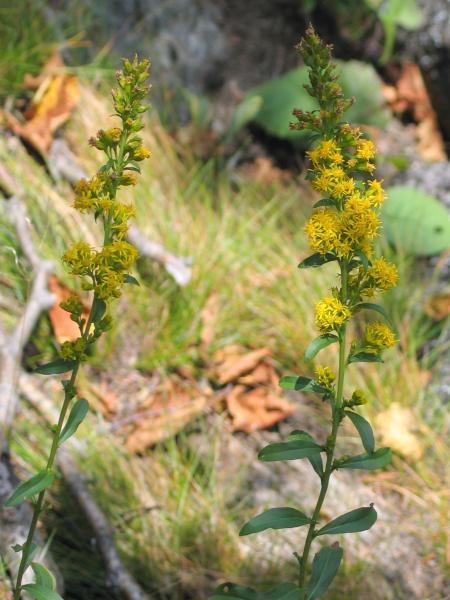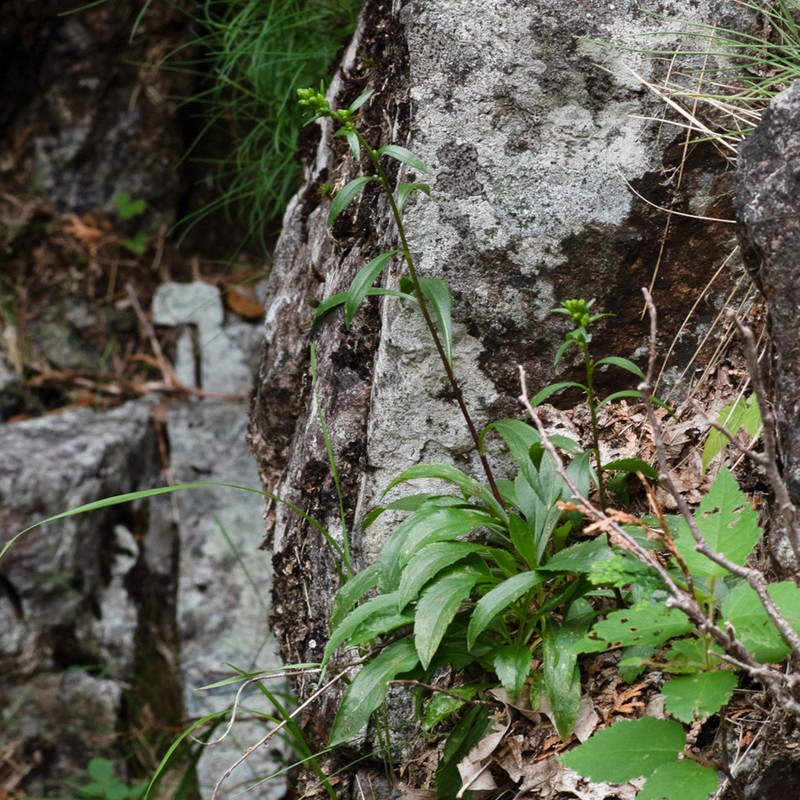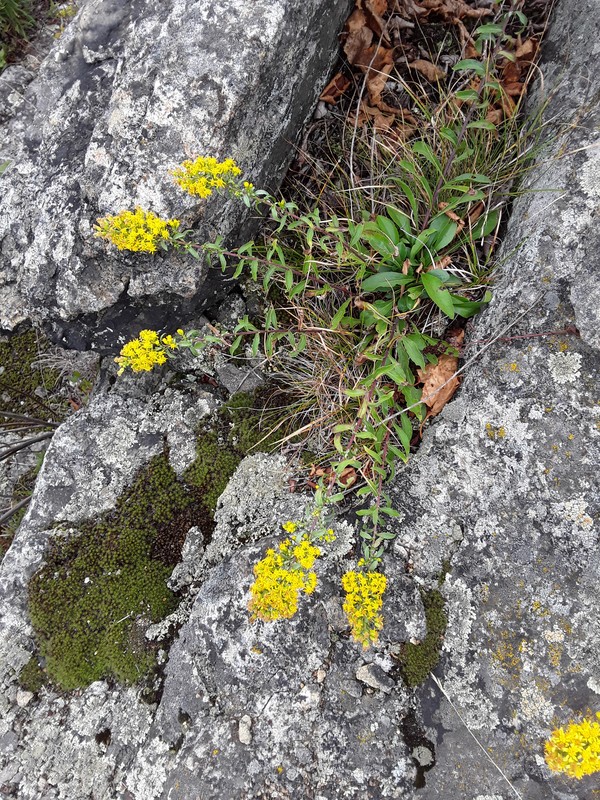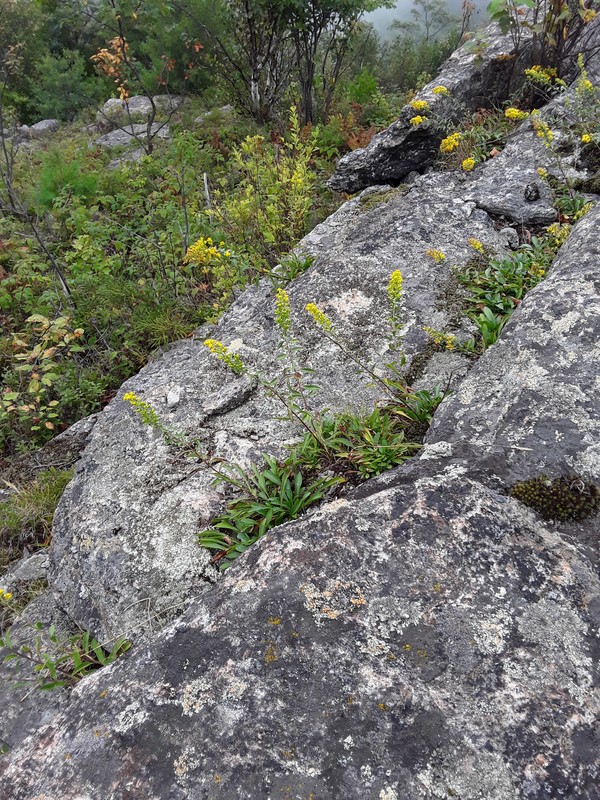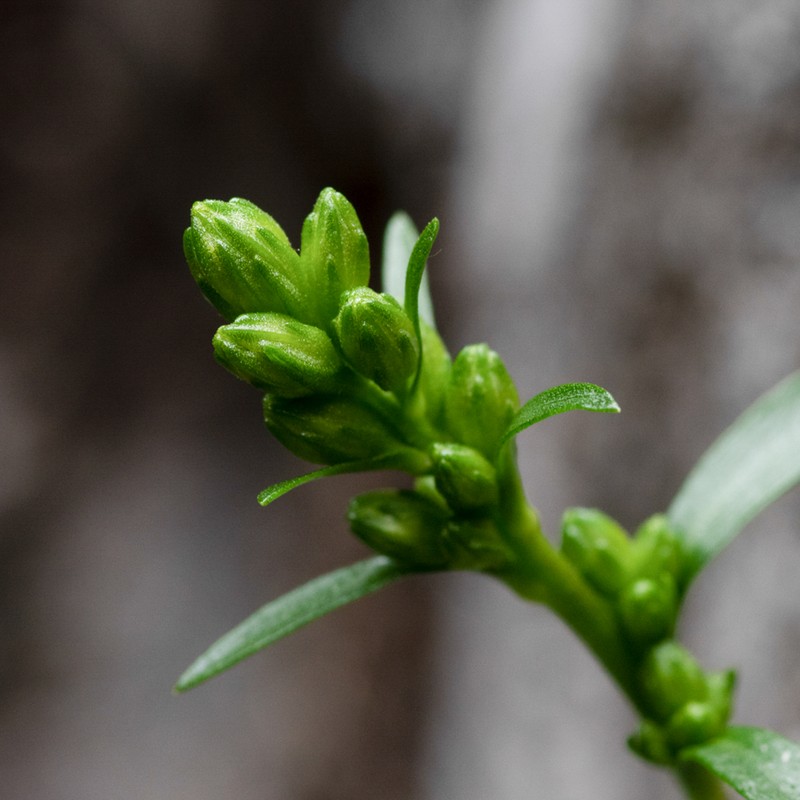Rand's Goldenrod
Solidago randii (Porter) Britt.
- Class
- Dicotyledoneae (Dicots)
- Family
- Asteraceae (Aster Family)
- State Protection
- Threatened
Listed as Threatened by New York State: likely to become Endangered in the foreseeable future. For animals, taking, importation, transportation, or possession is prohibited, except under license or permit. For plants, removal or damage without the consent of the landowner is prohibited.
- Federal Protection
- Not Listed
- State Conservation Status Rank
- S2S3
Imperiled or Vulnerable in New York - Very vulnerable, or vulnerable, to disappearing from New York, due to rarity or other factors; typically 6 to 80 populations or locations in New York, few individuals, restricted range, few remaining acres (or miles of stream), and/or recent and widespread declines. More information is needed to assign either S2 or S3.
- Global Conservation Status Rank
- G5T4
Apparently Secure globally - The subspecies/variety is uncommon in the world but not rare; usually widespread, but may be rare in some parts of its range; possibly some cause for long-term concern due to declines or other factors. (The species as a whole is common globally.)
Summary
Did you know?
The specific epithet monticola means dweller of the mountains. Although not a true alpine plant, this species is often found in mountainous regions.
State Ranking Justification
There are 21 known extant populations. At least six of these are very small with under 50 individuals.
Short-term Trends
There are no clear data on short-term trends.
Long-term Trends
Many new populations are being found in Essex County at middle elevationss on cliffs and rivershores. No populations are known to have become extirpated. Many of the populations are quite small with under 50 individuals, but there is no evidence that these populations are declining. Overall, long-term trends are unclear but may indicate a stable situation.
Conservation and Management
Threats
All of the populations appear to be secure, although in many cases quite small. There are no known threats.
Conservation Strategies and Management Practices
No management actions are currently needed.
Research Needs
Specimens need to be checked to confirm that they are not the closely related species S. simplex var. racemosa.
Habitat
Habitat
In New York, this taxon grows primarily on cliffs, ledges, and rock outcrops. It is also known from talus slopes below exposed rocky sites. The cliffs and ledges where this taxon occurs can be in forested areas or more often in exposed, open areas. The rocks are primarily acidic but this taxon also grows where there appears to be some calcareous influence. The populations are primarily in cool, relatively high elevation sites but it is not a member of the true alpine flora (New York Natural Heritage Program 2007). Dry serpentine soils, granitic rocky barren uplands of mountains below alpine slopes (Semple and Cook 2006). Plants mostly of cliffs and ledges (Haines and Vining 1998).
Associated Ecological Communities
- Acidic talus slope woodland
(guide)
An open to closed canopy woodland that occurs on talus slopes (slopes of boulders and rocks, often at the base of cliffs) composed of non-calcareous rocks such as granite, quartzite, or schist.
- Cliff community
(guide)
A community that occurs on vertical exposures of resistant, non-calcareous bedrock (such as quartzite, sandstone, or schist) or consolidated material; these cliffs often include ledges and small areas of talus.
- Spruce-fir rocky summit
(guide)
A community that occurs on cool, dry, rocky ridgetops and summits where the bedrock is non-calcareous (such as anorthosite, quartzite, or sandstone), and the soils are more or less acidic. The vegetation may be sparse or patchy, with numerous rock outcrops and rock slides. The species have predominantly boreal distributions.
Associated Species
- Campanula rotundifolia (hare-bell)
- Carex deflexa
- Carex scirpoidea ssp. scirpoidea (Canadian single-spike sedge)
- Corydalis sempervirens
- Cystopteris fragilis (fragile fern)
- Dasiphora floribunda
- Diervilla lonicera (bush-honeysuckle)
- Huperzia appressa (mountain firmoss)
- Polypodium virginianum (Virginian rock polypody, Virginian polypody)
- Saxifraga paniculata
- Schizachyrium scoparium
- Sibbaldiopsis tridentata
- Solidago hispida (hairy goldenrod)
- Sorbus americana (American mountain-ash)
- Thuja occidentalis (northern white cedar, arbor vitae)
- Trisetum spicatum (narrow oat grass)
- Woodsia ilvensis (rusty woodsia, rusty cliff fern)
Range
New York State Distribution
In New York, this taxon is known only from northern New York, mostly restricted to the Adirondacks.
Global Distribution
This taxon occurs as small disjunct populations throughout its range, which is from northern New York east to Massachusettes, Vermont, New Hampshire, Maine, and southern Quebec (Semple and Cook 2006)
Identification Comments
General Description
Rand's mountain goldenrod is a perennial herb. It is related and somewhat similar to other more widespread goldenrod species. The stems are 10-83 cm tall and have 3-35 leaves on them. Some leaves occur only as rosettes on the ground. The lower stem leaves are 4-16 cm long and have teeth on their margins while the upper leaves are 1-8 cm long. The flowers occur in dense clusters or heads with 3-150 heads per plant. The flowers are yellow, and similar to dandelions, the mature fruits have capillary hairs that aid in dispersal (Semple and Cook 2006).
Identifying Characteristics
Solidago randii has basal rosettes visible when in flower. The basal leaves are obovate to spatulate and acute or somewhat obtuse at their apices. The lower cauline leaves are obovate to spatulate and (5-)10-22(-31) mm wide. The leaves are crenate to serrate. The inflorescences are racemiform or open paniculiform with the heads not secund. The phyllaries, peduncles, and leaves are viscid (Semple and Cook 2006).
Best Life Stage for Proper Identification
Mature plants in flower or early fruit are easiest to identify.
Similar Species
This goldenrod can be distinguished from most others by its having heads in axillary clusters which are not secund, inflorescences racemiform to paniculiform, basal leaves present when in flower, and viscid phyllaries, peduncles, and leaves.
Solidago puberula can look somewhat similar. It differs from Solidago randii in having the stems densely puberulent and the plants not viscid.
Solidago racemosa grows in different habitat (rocks, usually calcareous, associated with rivers) but otherwise is quite similar. It differs in having the proximal cauline leaves lanceolate to narrowly spatulate (compared to obovate to spatulate), (2-)3.7-9.5(-17) mm long (compared to (5-)10-22(-31) mm long), and leaf margins entire or dentate, rarely serrate (compared to crenate to serrate) (Semple and Cook 2006).
Best Time to See
This taxon starts to flower in late July or early August and continues through mid-September depending on altitude. Since it is easiest to see this species when it is in full flower the best time to survey for this species is from August through mid-September, surveying lower elevations first.
- Flowering
- Fruiting
The time of year you would expect to find Rand's Goldenrod flowering and fruiting in New York.
Rand's Goldenrod Images
Taxonomy
Rand's Goldenrod
Solidago randii (Porter) Britt.
- Kingdom Plantae
- Phylum Anthophyta
- Class Dicotyledoneae
(Dicots)
- Order Asterales
- Family Asteraceae (Aster Family)
- Order Asterales
- Class Dicotyledoneae
(Dicots)
- Phylum Anthophyta
Synonyms
- Solidago randii var. monticola (Porter) Fernald
- Solidago simplex spp. randii var. monticola (Porter) Ringius
- Solidago simplex ssp. randii var. randii (Porter) Kartesz & Gandhi
- Solidago simplex var. monticola (Porter) Ringius
- Solidago simplex var. randii (Porter) Kartesz & Gandhi
- Solidago spathulata ssp. randii (Porter) Gleason [in part.]
- Solidago spathulata var. randii (Porter) Gleason
Comments on the Classification
This taxon has been recognized under the name Solidago glutinosa. The older name S. simplex, based on the type from Mexico, was found to be conspecific and takes priority at the species level (Nesom 1989). Within S. simplex two subspecies (ssp. simplex and ssp. randii) are recognized. Under ssp. randii four varieties (var. monticola, var. racemosa, var. gillmanii, and var. ontarioensis) are recognized (Ringius and Semple 1991, Semple and Cook 2006). Kartesz and Gandhi (1991) created the name S. simplex var. randii to replace S. simplex ssp. randii but the name monticola takes priority at the rank of variety. Therefore, the taxon detailed in this conservation guide is known by the quadrinomial Solidago simplex ssp. randii var. monticola (Ringius and Semple 1991, Semple and Cook 2006). It can also simply be called Solidago simplex var. monticola as all varieties under S. simplex (including both subspecies) have unique names in accordance with Greuter et al. (2000). Fernald (1970) and Gleason and Cronquist (1991) circumscribe this taxon slightly differently then is currently accepted and therefore only more recent authors (Haines and Vining 1998, Semple et al. 1999, Semple and Cook 2006) should be followed. The name was changed to Solidago simplex var. monticola in the Asteraceae, volume 20 of Flora of North America and the NY Flora Atlas. In 2007, we adopted this change.
Additional Resources
Best Identification Reference
Semple, J.C. and R.E. Cook. 2006. Solidago Linnaeus. Pages 107-166 in Flora of North America Editorial Committee (Editors), Flora of North America, north of Mexico, Volume 20, Magnoliophyta: Asteridae, part 7: Asteraceae, part 2, Asterales, part 2 (Aster order). Oxford University Press, New York, NY, USA. 666pp + xxii.
Other References
Fernald, M.L. 1950. Gray's manual of botany. 8th edition. D. Van Nostrand, New York. 1632 pp.
Flora of North America Editorial Committee. 2002. Flora of North America, North of Mexico. Volume 26. Magnoliophyta: Liliidae: Liliales and Orchidales. Oxford University Press, New York. 723 pp.
Gleason, Henry A. and A. Cronquist. 1991. Manual of Vascular Plants of Northeastern United States and Adjacent Canada. The New York Botanical Garden, Bronx, New York. 910 pp.
Greuter, W., J. McNeill, F.R. Barrie, H.M. Burdet, V. Demoulin, T.S. Filgueiras, D.H. Nicolson, P.C. Silva, J.E. Skog, P. Trehane, N.J. Turland, and D.L. Hawksworth (editors). 2000. International Code of Botanical Nomenclature (Saint Louis Code) adopted by the Sixteenth International Botanical Congress, St. Louis, Missouri, July-August 1999. Koeltz Scientific Books, Königstein, Germany.
Haines, A. and T.F. Vining. 1998. Flora of Maine, A Manual for Identification of Native and Naturalized Vascular Plants of Maine. V.F.Thomas Co., Bar Harbor, Maine.
Holmgren, Noel. 1998. The Illustrated Companion to Gleason and Cronquist's Manual. Illustrations of the Vascular Plants of Northeastern United States and Adjacent Canada. The New York Botanical Garden, Bronx, New York.
Kartesz, J.T. and K.N. Gandhi. 1991. Nomenclatural notes for the North American flora. VI. Phytologia 71: 58-65.
Nesom, G. 1989. Solidago simplex (Compositae: Astereae), the correct name for S. glutinosa. Phytologia 67: 155-157.
New York Natural Heritage Program. 2010. Biotics database. New York Natural Heritage Program. New York State Department of Environmental Conservation. Albany, NY.
New York Natural Heritage Program. 2024. New York Natural Heritage Program Databases. Albany, NY.
Reschke, Carol. 1990. Ecological communities of New York State. New York Natural Heritage Program, New York State Department of Environmental Conservation. Latham, NY. 96 pp. plus xi.
Ringius, G.S. and J.C. Semple. 1991. New combinations in Solidago simplex (Compositae: Astereae). Phytologia 70: 396-399.
Semple, J.C., G.S. Ringius, and J.J. Zhang. 1999. The Goldenrods of Ontrio: Solidago L. and Euthamia Nutt. 3rd Edition. University of Waterloo Biology Series, Number 39. University of Waterloo, Waterloo, Ontario, Canada.
Weldy, T. and D. Werier. 2010. New York flora atlas. [S.M. Landry, K.N. Campbell, and L.D. Mabe (original application development), Florida Center for Community Design and Research http://www.fccdr.usf.edu/. University of South Florida http://www.usf.edu/]. New York Flora Association http://newyork.plantatlas.usf.edu/, Albany, New York
Links
About This Guide
Information for this guide was last updated on: February 1, 2023
Please cite this page as:
New York Natural Heritage Program. 2024.
Online Conservation Guide for
Solidago randii.
Available from: https://guides.nynhp.org/rands-goldenrod/.
Accessed July 26, 2024.
